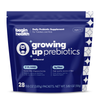Are Prebiotics Dairy-Free?
share this article

It is estimated that 1.9% of kids in the United States have a milk allergy [1]. Milk contains many different proteins, but casein and whey are the two groups of proteins most likely to be allergens. Prebiotics on the other hand, are non-digestible fibers that can contribute to healthier bowel movements by feeding good gut bacteria in the microbiome. One of the most common concerns we get from parents is whether prebiotics, essential for cultivating a thriving gut environment, are dairy-free. Let's explore this question and understand what prebiotics are and if our little ones who are dairy-free can implement it into their routine.
What Are Prebiotics and Why Do They Matter?
Prebiotics are fibers from plants that serve as nourishment for the beneficial bacteria in the gut. These microorganisms play a crucial role in supporting digestion and immune health. For kiddos struggling with constipation, prebiotics can help alleviate symptoms by supporting softer and more frequent stools.
Prebiotics and Dairy: The Connection
The good news for those seeking dairy-free options is that many prebiotics are naturally found in non-dairy sources. However, it’s always best to check ingredient labels to see if there’s a chance that it could have been packaged or cross-contaminated with dairy sources.
Dairy-Free Prebiotic Sources: A Nutrient-Rich Selection
A few examples of non-dairy prebiotic sources that can be easily incorporated into your kid’s diet may include:
Green Peas: Green peas contain resistant starch and fiber, both of which can act as prebiotics. A one-cup serving of green peas contains 7 grams of dietary fiber that can help with softer poops [2].
Pistachios: Studies reveal that the prebiotic fiber found in pistachios can potentially promote the growth of beneficial gut bacteria to support digestion and immunity [3].
Jicama: Jicama is high in prebiotic fiber in the form of inulin, which also serves to boost friendly bacteria in the gut for healthier digestion [4].
-
Buy Now
Join the
Happy Gut Club
Daily reads to help your little ones lead happier and healthier lives.
Begin Health Expert Tip
Growing Up Prebiotics contains 2-FL Human Milk Oligosaccharides (HMOs) that uses lactose as a starting ingredient, but after the process of fermentation, almost all the lactose is turned into the prebiotic human milk oligosaccharides. To put this in perspective on how much lactose is in our product, an 8oz cup of milk contains 12 grams of lactose. Our testing shows that there is around 4mg of lactose per packet (which is 0.03%, that is less than ½ a percent vs 1 cup of milk) and any residual lactose is not likely to cause any symptoms for kiddos with lactose intolerance.
For more information about whether kiddos with a lactose intolerance or cow’s milk allergy can use Growing Up Prebiotics, check out our blogs Can My Kid Use Growing Up Prebiotics If They Have A Lactose Intolerance? and Can My Kid Take Growing Up Prebiotics If They Are Allergic To Cow Milk Protein?
Summary
Prebiotics sources are generally naturally dairy-free, making them accessible and beneficial for kids with dairy-related dietary considerations. Always check the label on a product first to make sure there’s no additional cross contamination with dairy sources. Prebiotic sources can include plant-based foods such as green peas, pistachios, and jicama. While we always recommend consuming nutrients from whole food sources first, prebiotic supplements formulated specifically for kids such as Begin Health’s Growing Up Prebiotics can also be a helpful way to consume prebiotics, especially for pickier eaters.
















